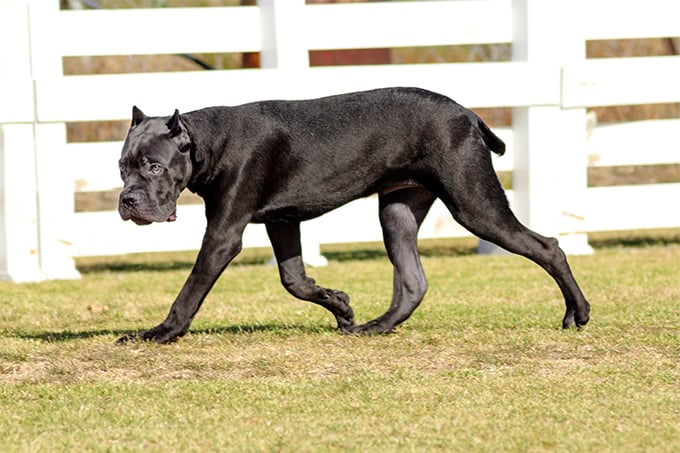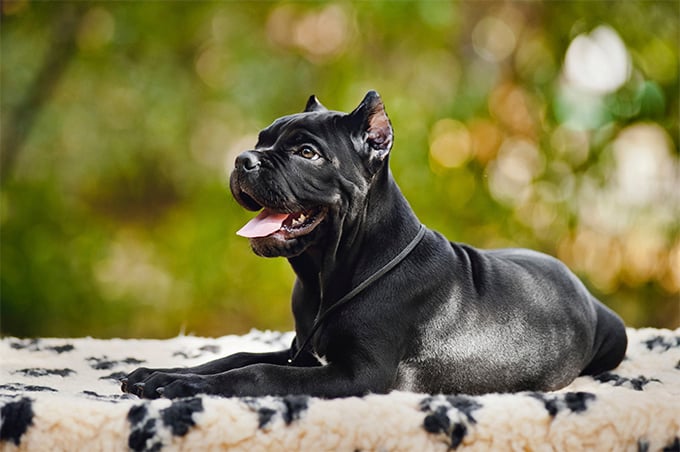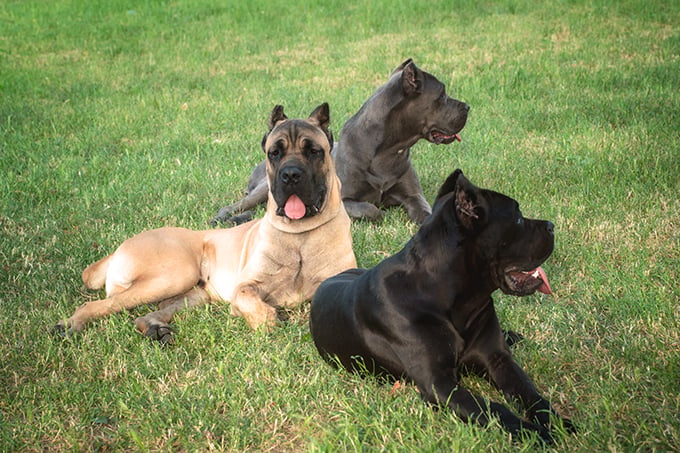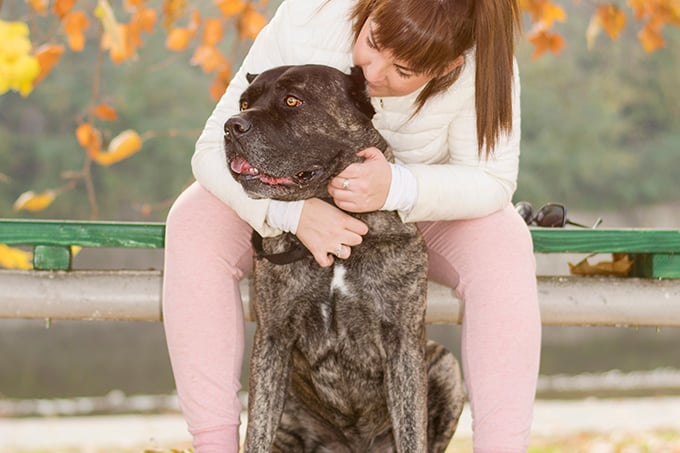Cane Corso Dog Breed Introduction
The Cane Corso is a large and impressive dog breed that originates from Italy. Also known as the Italian Mastiff, this breed has been valued for centuries for its exceptional guarding abilities, loyalty, and strength. With a powerful build and a muscular body, the Cane Corso is a force to be reckoned with, yet they also have a gentle and affectionate side that makes them great companions.
Cane Corso was originally bred for hunting wild boars and as a guard dog, and they have an instinctual drive to protect their family and territory. They are highly intelligent and trainable but require a confident and experienced owner who can provide them with firm and consistent training, as well as plenty of socialization from a young age.
Despite their imposing size and strength, Cane Corsos are also known for their calm and affectionate nature with their owners. They form strong bonds with their families and enjoy being around people. They are not typically aggressive towards humans, but they can be wary of strangers and other dogs if not properly socialized.
Cane Corsos have a short, dense coat that requires minimal grooming, and they come in a variety of colors, including black, gray, fawn, and red. They are a relatively healthy breed but may be prone to certain health issues such as hip dysplasia and bloat.
Overall, the Cane Corso is a majestic and loyal breed that requires a firm but a loving owner who can provide them with plenty of socialization, exercise, obedience training and mental stimulation. They make excellent guard dogs and loyal companions for those who are willing to put in the time and effort to properly train and care for them.
History

The Corso is a type of Mastiff, among many others. This one is Italian in origin, and its ancestry is traced back to ancient Roman combat canines. He was developed to be a versatile farm dog, hunter, and protector but is smaller in stature than his relative, the Neapolitan Mastiff. Their duties often included herding livestock like pigs or cattle to the market.
Of course, “cane” comes from the Latin word “canis,” which means “dog.” The word “corso” may have been borrowed from the Latin word “cohors,” which means “bodyguard,” or from the Latin word “corsus,” which meant “strong” in ancient Italian.
Dog lovers began their efforts to revive the Corso in the 1970s when the breed had nearly vanished due to the rise of automated farming. In 1983, the Society Amatori Cane Corso was established, and in 1996, the breed was recognized by the Federation Cynologique Internationale.
In 1988, Michael Sottile brought in America’s first litter of Corso’s, and two years later, he brought in another. In 1993, the world’s canine lovers banded together to form the International Cane Corso Association. The club’s efforts to gain official status for the breed with the American Kennel Club paid off in 2010. The Cane Corso Association of America is the current breed authority.
Nutritional Tips for Cane Corso Dogs

Providing proper nutrition is essential for keeping your Cane Corso healthy and happy. Here are some nutritional tips for Cane Corso dogs:
-
Choose a high-quality dog food
Look for a dog food that lists a meat protein as the first ingredient, such as chicken, beef, or fish. Avoid dog foods that contain fillers, by-products, or artificial preservatives.
-
Consider your Cane Corso’s age and activity level
Young puppies and active adult dogs will require more calories and protein than a senior or less active dog. Make sure to choose a dog food that is appropriate for your dog’s life stage and activity level.
-
Feed the appropriate amount
Overfeeding can lead to obesity and health issues, while underfeeding can lead to malnourishment. Follow the feeding guidelines on your dog food package, and adjust the amount based on your dog’s body condition and activity level.
-
Provide fresh water
Make sure your Cane Corso always has access to clean, fresh water. Dehydration can lead to serious health issues, and large dogs like Cane Corsos require a lot of water to stay hydrated.
-
Consider Supplements
Depending on your Cane Corso’s health needs, supplements such as glucosamine and chondroitin can help support joint health, while omega-3 fatty acids can promote healthy skin and coat.
-
Be aware of potential food allergies
Some Cane Corsos may have food allergies or sensitivities, so it’s important to be aware of any signs of an adverse reaction to their food, such as itching, vomiting, or diarrhea.
-
Avoid overfeeding treats
While treats can be a great way to reward your Cane Corso, overfeeding treats can lead to weight gain and other health issues. Choose treats that are low in calories and made with high-quality ingredients.
Cane Corso Grooming Guide

The cane Corso’s double coat is short and rough. There is a correlation between the environment a dog lives in and the length of its undercoat; canines residing in colder regions will have longer, thicker undercoats than their warmer-climate counterparts.
The cane corso, like other double-coated breeds, will shed quite a bit every year, but especially so in the spring. Yet, these dogs have relatively simple maintenance requirements; a weekly brushing year-round, additional grooming sessions during the shedding season and the occasional bath are usually sufficient. These dogs do not benefit from trims or haircuts of any kind.
The Cane Corso’s nails, like those of other large breeds of dog, may gradually wear down from normal use, especially if the dog spends a lot of time walking on concrete or other rough surfaces. On the other hand, you could need regular nail trims. Be sure to keep an eye on your dog’s nail length on a regular basis to ensure that it can move around freely and comfortably.
Although the Cane Corso’s ears are typically clipped into a triangle, this is not required by the breed standard. Common practice calls for the tail to be severed at the fourth vertebra.
Training Cane Corso puppy

Puppy classes and early socialization are beneficial for all dogs, but especially so for a large, powerful breed like the Cane Corso. There are many dominating and protective Cane Corsos, and early socialization will assist guarantee that they mature into pleasant, well-behaved adults.
They won’t grow up to be the dominant member of the family if they’re taught to obey the rules. Cane Corsos, being smart and eager to please, is quite simple to teach. Cane Corsos aren’t as imposing as they may seem, and they respond better to positive reinforcement and affection than they do to punishment.
Cane Corsos Health Issues

Like all dog breeds, the Cane Corso can be prone to certain health issues. Here are some of the most common health issues that Cane Corso owners should be aware of:
-
Hip dysplasia
This is a common issue in many large dog breeds, including the Cane Corso. It is a hereditary condition that affects the hip joints and can cause pain, lameness, and arthritis.
-
Elbow dysplasia
Similar to hip dysplasia, elbow dysplasia is a hereditary condition that affects the elbow joints and can cause pain, lameness, and arthritis.
-
Bloat
Also known as gastric torsion or twisted stomach, bloat is a serious and potentially life-threatening condition that can occur in large and deep-chested breeds like the Cane Corso. It is caused by the stomach filling with gas and twisting on itself, cutting off blood supply to the stomach and other organs.
-
Cherry eye
This is a condition where the gland that produces tears in the eye becomes inflamed and protrudes from the eye, causing a red, cherry-like appearance. It is more common in certain breeds, including the Cane Corso.
-
Skin issues
Cane Corsos can be prone to skin allergies and infections, which can cause itching, rashes, and hair loss.
It’s important to note that not all Cane Corsos will develop these health issues, and responsible breeders will screen their dogs for any hereditary conditions before breeding them. As a potential owner, it’s important to do your research, choose a reputable breeder, and be prepared to provide your Cane Corso with regular veterinary care to keep them healthy and happy.
A Cane Corso: Where to Get One

If you’re considering getting a Cane Corso, it’s a good idea to find local breeders and owners so you can meet and interact with the dogs. You might also look for a cane corso rescue organization that would welcome an adoption from you. If you’re considering adding a dog of this breed to your family, do your research first. The Cane Corso Association of America is a good place to start looking. The average cost of a puppy is $1,500, while a purebred Cane Corso puppy can cost tens of thousands of dollars.
See whether a cane corso is up for adoption at your neighborhood shelter or via a rescue organization. Cane Corso Rescue and other organizations specializing in large and giant breeds may have adoptable cane corsos.
In a Nutshell
Cane Corsos make wonderful guard dogs and affectionate companions. A steady regimen of socializing and training throughout the course of their life is necessary for bringing out their mellow, loving nature. But, the peace of mind gained from keeping a Cane Corso at home is well worth the additional effort. Anyone looking for a gigantic dog should be prepared to devote a great deal of time and effort to training, mental stimulation, and physical activity for this breed.
